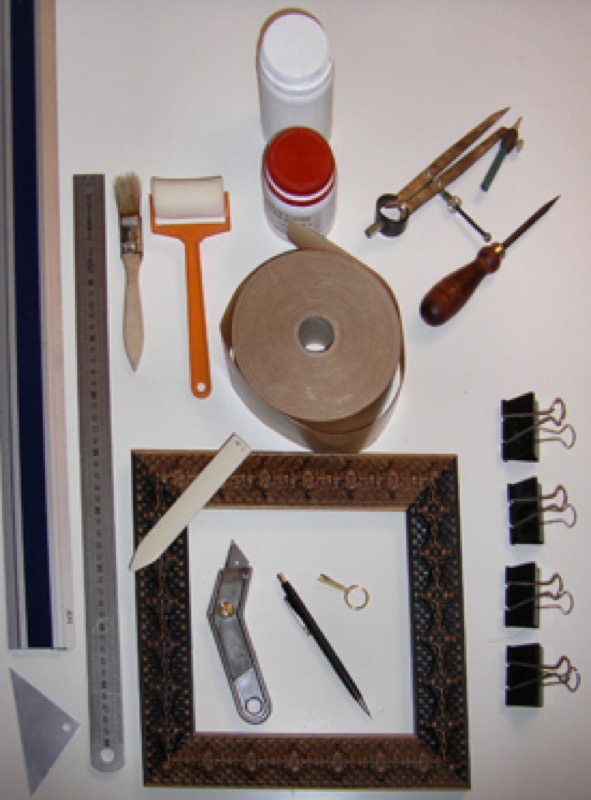From glue to the work area, here is an overview of framing tools and accessories. From the essentials for novices to specialized tools reserved for professionals…
1. Glues
- PH neutral white vinyl glue is suitable for most projects. It can be applied with a roller or paintbrush. Note: do not use this glue on valuable items.
- PH neutral tylose glue (in powdered form): is used diluted to glue delicate items.
- Quick setting wood glue: for gluing molding strips.

2. Frame construction
From traditional glass frames to elaborately carved hand-crafted frames, the possibilities are endless.
You'll need:
- Adhesive kraft tape (variable width, from 24 to 72 mm). Choose white to affix the artwork on the mounting board, and ecru for assembling the package components.
- A piece of glass of 2 mm thick, cut to the size of the package.
- Hanging hardware: triangle hangers or round hanging rings, to be attached to the backing board by means of a 1.5 cm wide linen tape. There are various systems for hanging, some of which are attached directly to the frame, and are specially designed for very heavy or large frames.
- A frame. Would you like to make your own? You'll need four molding strips, in the material and color of your choosing. Note that many suppliers you will offer to cut and join them for you. Will you also choose your own finishes? You will need a framing table saw, small headless nails and a frame press.
Close-up: "Homemade" moldings…
How long should the lengths of molding be? Twice the length of the package + twice the width of the package + 4 times the thickness of the molding.
In order to frame a work 20 x 30 cm with a 3 cm wide molding:
2 x 20 + 2 x 30 + 4 x 3 = 112 cm.
Even professionals need room for error… Be sure you have purchased an extra ten centimeters of molding to provide a margin of safety…
3. Essential equipment
- Work surface made of cardboard or glass
- Glazing surface (made of glass, to be used for preparing the components for adhesion, will be entirely covered with glue)
- Clamps and wooden panels for pressing your project
- A heavy stainless steel ruler (80 cm), an aluminum ruler (50 cm)
- T-square and metal corner template
- Brush and glue roller
- Compass (ideally with two points), scissors, utility knife
- 2 mechanical pencils: One for very thin leads (0.3 to 0.5 mm) HB, another for oily leads (2B or 3B) of standard thickness
- Fountain pens or fine tip markers for drawing filigree lines
- Paintbrushes, watercolors or India ink for washes
- Stylus or awl for making guide marks, or to indicate a fold line, etc.
- 1 bone folder
- 4 metal clips
- Blotters
4. "Extras" for professionals
- PVC work surface, an ideal cutting surface
- 1 curve-handled utility knife, to facilitate bevel cutting
- 1 spray gun or 1 bendable ruler for circular layouts
Recommended product:
Concerto® mount boards
See also :
Framing
Framing: French bevel
